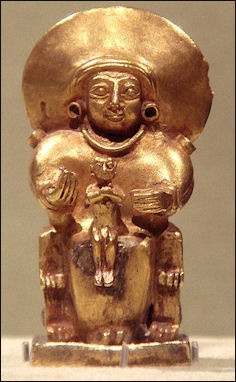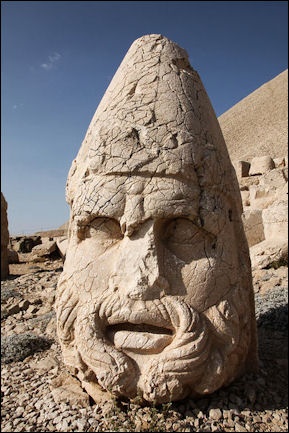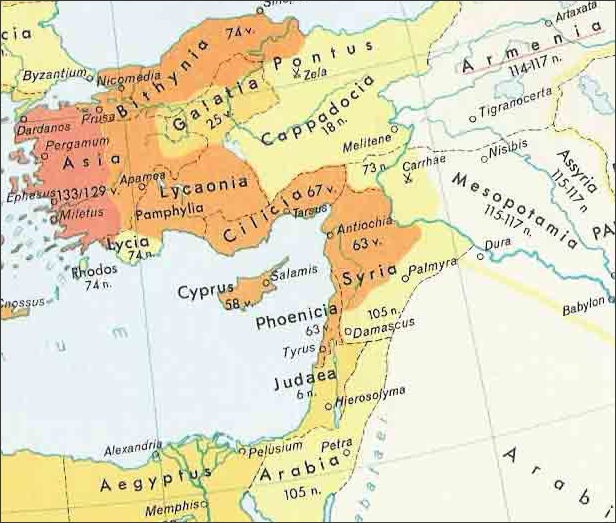ANCIENT ANATOLIA

Hittite goddess
Archeologists have long theorized that agriculture and settlement began in Mesopotamia and Palestine are spread north into Anatolia. Many archeologist reject this theory. Harald Hauptmann of the German Archeological Institute in Turkey old U.S. News and World Report, “Up here we see developments toward settled life, all over the place.”
The land mass occupied by the Asian part of the Republic of Turkey, east of the Sea of Marmara, is known as Anatolia. The region was inhabited by an advanced Neolithic culture as early as the seventh millennium B.C., and metal instruments were in use by 2500 B.C. Late in the third millennium B.C., the warrior Hittites invaded Anatolia and established an empire that made significant economic and administrative advancements. In about 1200 B.C., the Phrygians overthrew the Hittites in western Anatolia, where a Phrygian kingdom then ruled until the seventh century B.C. That kingdom was succeeded by a Lydian kingdom, which in turn was conquered by the Persians in 546 B.C. Meanwhile, beginning in about 1050 B.C., Ionian Greeks began founding cities along the Aegean coast of Anatolia, and in the eighth century B.C., peoples such as the Armenians and the Kurds moved into eastern Anatolia.
In the late fourth century B.C., Alexander the Great of Macedonia conquered all of Anatolia. One of the city-states that Alexander founded, Pergamum, became a unique center of wealth and culture. In 133 B.C., Pergamum became the center of a Roman province and remained a cultural center for several centuries. In 330 A.D., the Roman emperor Constantine established the capital of the Greek-speaking half of his empire at Byzantium, on the Sea of Marmara. The city was renamed Constantinople, and the eastern half of the Roman Empire became known as the Byzantine Empire. With its center in Anatolia, the Byzantine Empire remained a powerful entity until the eleventh century. The Patriarchiate of Constantinople, established in the fourth century, represented the Greek-speaking Roman Empire in the Christian church. [Source: Library of Congress, 2008 *]
Turkish tribes began to migrate westward from China and Central Asia in the seventh century A.D. In 1071 Seljuk Turkish forces defeated a Byzantine army at Manzikert and then occupied all of Anatolia. In the next few centuries, several Seljuk states were established. Gazi warriors, tribal horsemen charged with defending the Seljuk frontier, pushed relentlessly westward, and Seljuk governments eventually followed. In 1097 the Christian world responded to this movement with the first in a series of religiously inspired military crusades, which reclaimed part of Anatolia. However, in the next two centuries what was left of the Byzantine Empire fragmented. In the fourteenth century, a new power, the Osmanli Dynasty, came to dominate Anatolia.*
Websites and Resources: Ottoman Empire and Turks: The Ottomans.org theottomans.org ; Ottoman Text Archive Project – University of Washington courses.washington.edu ; Wikipedia article on the Ottoman Empire Wikipedia ; Encyclopædia Britannica article on the Ottoman Empire britannica.com ; American Travelers to the Holy Land in the 19th Century Shapell Manuscript Foundation shapell.org/historical-perspectives/exhibitions ; Ottoman Empire and Turk Resources – University of Michigan umich.edu/~turkis ; Turkey in Asia, 1920 wdl.org ; Wikipedia article on the Turkish People Wikipedia ; Turkish Studies, Turkic republics, regions, and peoples at University of Michigan umich.edu/~turkish/turkic ; Türkçestan Orientaal's links to Turkic languages users.telenet.be/orientaal/turkcestan ; Turkish Culture Portal turkishculture.org ; ATON, the Uysal-Walker Archive of Turkish Oral Narrative at Texas Tech University aton.ttu.edu ; The Horse, the Wheel and Language, How Bronze-Age Riders from the Eurasian Steppes shaped the Modern World", David W Anthony, 2007 archive.org/details/horsewheelandlanguage ; Wikipedia article on Eurasian nomads Wikipedia
Ancient Anatolia

Nemrut Dag
There is abundant archaeological evidence of a thriving neolithic culture in Anatolia at least as early as the seventh millennium B.C. What may have been the world's first urban settlement (dated ca. 6500 B.C.) has been uncovered at Çatalhüyük in the Konya Ovasi (Konya Basin). Introduced early in the third millennium B.C., metallurgy made possible a flourishing "copper age" (ca. 2500-2000 B.C.) during which cultural patterns throughout the region were remarkably uniform. The use of bronze weapons and implements was widespread by 2000 B.C. Colonies of Assyrian merchants, who settled in Anatolia during the copper age, provided metal for the military empires of Mesopotamia, and their accounts and business correspondence are the earliest written records found in Anatolia. From about 1500 B.C., southern Anatolia, which had plentiful sources of ore and numerous furnace sites, developed as a center of iron production. Two of the area's most celebrated archaeological excavations are the sites at Troy and Hattusas (Bogazköy). [Source: Library of Congress, January 1995 *]
The cape projecting into the Aegean between the Dardanelles and the Gulf of Edremit was known in antiquity as Troas. There, a thirty-meter-high mound called Hisarlik was identified as the site of ancient Troy in diggings begun by German archaeologist Heinrich Schliemann in the 1870s. The first five levels of the nine discovered at Hisarlik contained remains of cities from the third millennium B.C. that controlled access to the shortest crossing of the Dardanelles and that probably derived their prosperity from tolls. Artifacts give evidence of 1,000 years of cultural continuity in the cities built on these levels. A sharp break with the past occurred on the sixth level, settled about 1900 B.C. by newcomers believed to have been related to the early Greeks. Built after an earthquake devastated the previous city about 1300 B.C., the seventh level was clearly the victim of sacking and burning about 1150 B.C., and it is recognized as having been the Troy of Homer's Iliad . Hisarlik subsequently was the site of a Greek city, Ilion, and a Roman one, Ilium.*
Hittites
Late in the third millennium B.C., waves of invaders speaking Indo-European languages crossed the Caucasus Mountains into Anatolia. Among them were the bronze-working, chariot-borne warriors who conquered and settled the central plain. Building on older cultures, these invaders borrowed even their name, the Hittites, from the indigenous Hatti whom they had subjugated. They adopted the native Hattic deities and adapted to their written language the cuneiform alphabet and literary conventions of the Semitic cultures of Mesopotamia. The Hittites imposed their political and social organization on their dominions in the Anatolian interior and northern Syria, where the indigenous peasantry supported the Hittite warrior caste with rents, services, and taxes. In time the Hittites won reputations as merchants and statesmen who schooled the ancient Middle East in both commerce and diplomacy. The Hittite Empire achieved the zenith of its political power and cultural accomplishment in the fourteenth and thirteenth centuries B.C., but the state collapsed after 1200 B.C. when the Phrygians, clients of the Hittites, rebelled and burned Hattusas. [Source: Library of Congress, January 1995 *]
Phrygians and Lydians
The twelfth to ninth centuries B.C. were a time of turmoil throughout Anatolia and the Aegean world. The destruction of Troy, Hattusas, and numerous other cities in the region was a collective disaster that coincided with the rise of the aggressive Assyrian Empire in Mesopotamia, the Dorian invasion of Greece, and the appearance of the "sea peoples" who ravaged the Aegean and eastern Mediterranean. [Source: Library of Congress, January 1995 *]
The first light to penetrate the dark age in Anatolia was lit by the very Phrygians who had destroyed Hattusas. Architects, builders, and skilled workers of iron, they had assimilated the Hittites' syncretic culture and adopted many of their political institutions. Phrygian kings apparently ruled most of western and central Anatolia in the ninth century B.C. from their capital at Gordium (a site sixty kilometers southwest of modern Ankara). Phrygian strength soon waned, however, and the kingdom was overthrown in the seventh century B.C. by the Cimmerians, a nomadic people who had been pursued over the Caucasus into Anatolia by the Scythians.*
Order was restored in Anatolia by the Lydians, a Thracian warrior caste who dominated the indigenous peasantry and derived their great wealth from alluvial gold found in the tributaries of the Hermus River (Gediz Nehri). From their court at Sardis, such Lydian kings as Croesus controlled western Anatolia until their kingdom fell to the Persians in 546 B.C.

Homeland of different Anatolian cultures that existed in Mesopotamian and Greek times
Armenians and Kurds
The Armenians took refuge in the Lake Van region in the seventh century B.C., apparently in reaction to Cimmerian raids. Their country was described by Xenophon around 400 B.C. as a tributary of Persia. By the first century B.C., a united Armenian kingdom that stretched from the Black Sea to the Caspian Sea had been established as a client of the Roman Empire to buffer the frontier with Persia.*
Xenophon also recorded the presence of the Kurds. Contemporary linguistic evidence has challenged the previously held view that the Kurds are descendants of the Medes, although many Kurds still accept this explanation of their origin. Kurdish people migrated from the Eurasian steppes in the second millennium B.C. and joined indigenous inhabitants living in the region.*
Greeks in Anatolia
The Aegean coast of Anatolia was an integral part of a Minoan-Mycenean civilization (ca. 2600-1200 B.C.) that drew its cultural impulses from Crete. During the Aegean region's so-called Dark Age (ca. 1050-800 B.C.), Ionian Greek refugees fled across the sea to Anatolia, then under Lydian rule, to escape the onslaught of the Dorians. Many more cities were founded along the Anatolian coast during the great period of Greek expansion after the eighth century B.C. One among them was Byzantium, a distant colony established on the Bosporus by the city-state of Megara. Despite endemic political unrest, the cities founded by the Ionians and subsequent Greek settlers prospered from commerce with Phrygia and Lydia, grew in size and number, and generated a renaissance that put Ionia in the cultural vanguard of the Hellenic world. [Source: Library of Congress, January 1995 *]
At first the Greeks welcomed the Persians, grateful to be freed from Lydian control. But when the Persians began to impose unpopular tyrants on the city-states, the Greeks rebelled and called on their kinsmen in Greece for aid. In 334 B.C., Alexander the Great crossed the Hellespont, defeated the Persians at the Granicus River (Biga Çayi), and during four years of campaigning liberated the Ionian city-states, incorporating them into an empire that at his death in 323 B.C. stretched from the Nile to the Indus.*
After Alexander died, control of Anatolia was contested by several of the Macedonian generals among whom his empire was divided. By 280 B.C. one of them, Seleucus Nicator, had made good his claim to an extensive kingdom that included southern and western Anatolia and Thrace as well as Syria, Mesopotamia, and, for a time, Persia. Under the Seleucid Dynasty, which survived until 64 B.C., colonists were brought from Greece, and the process of hellenization was extended among the non-Greek elites.*

Anatolia During the early Roman Empire around 200 BC
The Seleucids were plagued by rebellions, and their domains in Anatolia were steadily eaten away by secession and attacks by rival Hellenistic regimes. Pergamum became independent in 262 B.C., during the Attalid Dynasty, and won fame as the paragon of Hellenistic states. Noted for the cleanliness of its streets and the splendor of its art, Pergamum, in west-central Anatolia, derived its extraordinary wealth from trade in pitch, parchment, and perfume, while slave labor produced a food surplus on scientifically managed state farms. It was also a center of learning that boasted a medical school and a library second in renown only to that of Alexandria. But Pergamum was both despised and envied by the other Greek states because of its alliance with Rome.*
Rome and the Byzantine Empire
The last of the Attalid kings bequeathed Pergamum to his Roman allies upon his death in 138 B.C. Rome organized this extensive territory under a proconsul as the province of Asia. All of Anatolia except Armenia, which was a Roman client-state, was integrated into the imperial system by A.D. 43. After the accession of the Roman emperor Augustus (r. 27 B.C.-A.D. 14), and for generations thereafter, the Anatolian provinces enjoyed prosperity and security. The cities were administered by local councils and sent delegates to provincial assemblies that advised the Roman governors. Their inhabitants were citizens of a cosmopolitan world state, subject to a common legal system and sharing a common Roman identity. Roman in allegiance and Greek in culture, the region nonetheless retained its ethnic complexity. [Source: Library of Congress, January 1995 *]
In A.D. 285, the emperor Diocletian undertook the reorganization of the Roman Empire, dividing jurisdiction between its Latin-speaking and Greek-speaking halves. In 330 Diocletian's successor, Constantine, established his capital at the Greek city of Byzantium, a "New Rome" strategically situated on the European side of the Bosporus at its entrance to the Sea of Marmara. For nearly twelve centuries the city, embellished and renamed Constantinople, remained the capital of the Roman Empire--better known in its continuous development in the East as the Byzantine Empire.*
Christianity was introduced to Anatolia through the missionary activity of Saint Paul, a Greek-speaking Jew from Tarsus in Cilicia, and his companions. Christians possibly even constituted a majority of the population in most of Anatolia by the time Christianity was granted official toleration under the Edict of Milan in A.D. 313. Before the end of the fourth century, a patriarchate was established in Constantinople with ecclesiastical jurisdiction over much of the Greek East. The basilica of Hagia Sophia (Holy Wisdom), whose construction in Constantinople was ordered by Emperor Justinian in 532, became the spiritual focus of Greek Christendom.*

Byzantine Empire around AD 600
Although Greek in language and culture, the Byzantine Empire was thoroughly Roman in its laws and administration. The emperor's Greek-speaking subjects, conscious of their imperial vocation, called themselves romaioi --Romans. Almost until the end of its long history, the Byzantine Empire was seen as ecumenical--intended to encompass all Christian peoples--rather than as a specifically Greek state.*
In the early seventh century, the emperor in Constantinople presided over a realm that included not only Greece and Anatolia but Syria, Egypt, Sicily, most of Italy, and the Balkans, with outposts across North Africa as far as Morocco. Anatolia was the most productive part of this extensive empire and was also the principal reservoir of manpower for its defense. With the loss of Syria to Muslim conquest in the seventh century, Anatolia became the frontier as well as the heartland of the empire. The military demands imposed on the Byzantine state to police its provinces and defend its frontiers were enormous, but despite the gradual contraction of the empire and frequent political unrest, Byzantine forces generally remained strong until the eleventh century.*
Image Sources: Wikimedia Commons
Text Sources: New York Times, Washington Post, Los Angeles Times, Times of London, Lonely Planet Guides, Library of Congress, U.S. government, Compton’s Encyclopedia, The Guardian, National Geographic, Smithsonian magazine, The New Yorker, Time, Newsweek, Reuters, AP, AFP, Wall Street Journal, The Atlantic Monthly, The Economist, Foreign Policy, Wikipedia, BBC, CNN, and various books, websites and other publications.
Last updated May 2016
